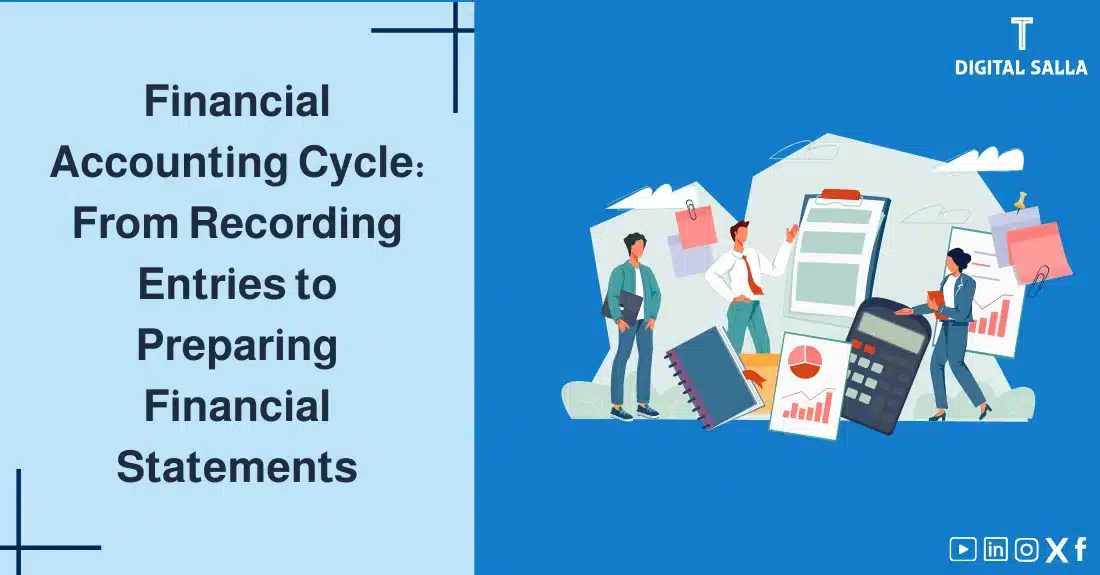The Financial Accounting Cycle: From Recording Entries to Preparing Financial Statements

The Financial Accounting Cycle represents a sequential series of interconnected steps used to record, process, summarize, and present an entity’s financial information during a specific period, usually a fiscal year. The accounting cycle begins with recording accounting entries and ends with preparing financial statements, passing through stages of posting, balancing, and preparing a trial balance. A thorough understanding of this cycle is essential for anyone working in financial accounting or seeking to understand how financial reports are prepared and analyzed.
What is the Financial Accounting Cycle?
The financial accounting cycle is the set of sequential steps performed to transform data related to an entity’s financial transactions into useful financial information, presented in the form of financial statements. This cycle includes all activities related to collecting, recording, classifying, summarizing, and presenting financial data.
Steps of the Financial Accounting Cycle:
- Identifying and Analyzing Transactions:
- The first step in the financial accounting cycle is to identify the financial transactions that the entity has undertaken during the financial period. These transactions include all economic events that have a financial impact on the entity, such as purchasing and selling goods, collecting revenues, paying expenses, and obtaining loans.
- Analysis: After identifying the financial transaction, it is analyzed to understand its nature and determine the accounts affected (increased or decreased) according to the accounting equation (Assets = Liabilities + Equity). The accountant must have a deep understanding of accounting principles to be able to analyze financial transactions correctly.
- Recording Transactions in the Journal:
- Recording Entries: After analyzing the financial transaction, it is recorded in the Journal in the form of an accounting entry consisting of two sides: a debit side and a credit side, according to the double-entry bookkeeping rule. The total debit amounts must equal the total credit amounts in each entry.
- Journal: It is a chronological record in which all financial transactions of the entity are recorded as they occur, arranged according to the date of their occurrence. The Journal serves as the initial record in which all accounting entries are recorded.
- Importance of the Journal:
- Initial and immediate recording of all financial transactions.
- Providing a sequential historical record of all financial transactions.
- Verifying the accuracy of accounting entries before posting them to the Ledger.
- Easily referring to the details of any financial transaction.
- Posting to the Ledger:
- Posting: It is the process of transferring information from the Journal to the relevant accounts in the Ledger.
- Ledger: It is a record that includes all the entity’s accounts, where a page or more is allocated to each account. Each side of the entry is posted to its respective account in the Ledger, with the date and entry number in the Journal recorded.
- Purpose of Posting: To group all movements related to a specific account in one place, making it easy to know the account balance at any time.
- Preparing an Unadjusted Trial Balance:
- Trial Balance: It is a list of all Ledger accounts and their balances at the end of the financial period (before making adjustments).
- Purpose: The unadjusted trial balance is prepared to verify the balance of accounting entries (i.e., the equality of the total debit balances with the total credit balances) and to ensure the accuracy of the posting process from the Journal to the Ledger.
- Note: An imbalance in the trial balance indicates an error in recording accounting entries or in the posting process.
- Recording Adjusting Entries:
- Adjusting Entries: These are accounting entries made at the end of the financial period to adjust the balances of some accounts, to ensure the application of the accrual basis of accounting and the matching principle (matching revenues with expenses).
- Importance of Adjusting Entries: Adjusting entries ensure that financial statements accurately reflect the entity’s financial reality by recognizing all earned revenues and incurred expenses during the financial period.
- Examples of Adjusting Entries:
- Accrued Revenues: Revenues earned during the financial period but not yet collected or recorded.
- Example: Providing services to customers but not collecting fees until the end of the financial period.
- Entry: Dr. Accounts Receivable (or Debtors) (Debit), Cr. Accrued Revenues (Credit)
- Accrued Expenses: Expenses incurred during the financial period but not yet paid or recorded.
- Example: Employees’ salaries due for December but not paid until the end of the fiscal year.
- Entry: Dr. Salaries Expense (Debit), Cr. Salaries Payable (Credit)
- Prepaid Expenses: Expenses paid in advance and relating to more than one financial period.
- Example: Paying rent for a full year in advance.
- Entry: Upon payment: Dr. Prepaid Rent Expense (Debit), Cr. Cash (Credit). At the end of the period: Dr. Rent Expense (Debit), Cr. Prepaid Rent Expense (Credit).
- Unearned Revenues: Revenues collected in advance for services or goods not yet provided.
- Example: Collecting two months’ rent in advance from a tenant.
- Entry: Upon collection: Dr. Cash (Debit), Cr. Unearned Rent Revenue (Credit). At the end of the period: Dr. Unearned Rent Revenue (Debit), Cr. Rent Revenue (Credit).
- Depreciation of Fixed Assets: Allocating the cost of a fixed asset over its useful life.
- Example: Purchasing a car for 50,000 Riyals with a useful life of 5 years.
- Entry: Dr. Depreciation Expense (Debit), Cr. Accumulated Depreciation (Credit).
- Inventory Adjustment: The adjustment of the ending inventory to its actual balance.
- Accrued Revenues: Revenues earned during the financial period but not yet collected or recorded.
- Preparing an Adjusted Trial Balance:
- Adjusted Trial Balance: It is a list of all Ledger accounts and their balances after making adjusting entries.
- Purpose: The adjusted trial balance is prepared to ensure the accuracy of account balances after adjustments and the balance of accounting entries before preparing financial statements.
- Preparing Financial Statements:
- Financial Statements: A set of reports that present the entity’s financial information in an organized and concise manner. Financial statements are the final product of the financial accounting cycle.
- Main Types of Financial Statements:
- Income Statement: Shows the entity’s results of operations (profit or loss) during the financial period. The income statement is prepared using revenue and expense accounts.
- Income Statement Equation: Net Profit (or Loss) = Revenues – Expenses
- Balance Sheet: Shows the entity’s assets, liabilities, and equity at a specific date (usually the end of the financial period). The balance sheet is prepared using asset, liability, and equity accounts.
- Accounting Equation: Assets = Liabilities + Equity
- Cash Flow Statement: Shows the movement of cash in and out of the entity during the financial period, classifying cash flows into operating, investing, and financing activities.
- Statement of Changes in Equity: Shows the changes that occurred in the entity’s equity during the financial period, such as retained earnings, dividends, and the issuance of new shares.
- Income Statement: Shows the entity’s results of operations (profit or loss) during the financial period. The income statement is prepared using revenue and expense accounts.
- Recording Closing Entries:
- Closing Entries: Accounting entries made at the end of the financial period to close (zero out) the balances of temporary accounts (revenues, expenses, and sometimes withdrawals) and transfer their impact to the Retained Earnings account (or Capital account in sole proprietorships).
- Purpose: To prepare temporary accounts for the new financial period and reflect the net profit or loss on the equity accounts.
- Steps to Close Temporary Accounts:
- Closing Revenue Accounts: Revenue accounts are closed by making them debit and making the Income Summary (or Profit and Loss) account credit.
- Closing Expense Accounts: Expense accounts are closed by making them credit and making the Income Summary (or Profit and Loss) account debit.
- Closing the Income Summary Account: The Income Summary (or Profit and Loss) account is closed to the Retained Earnings (or Capital) account. If the Income Summary balance is credit (profit), it is made debit and the Retained Earnings account is made credit. If the Income Summary balance is debit (loss), it is made credit and the Retained Earnings account is made debit.
- Closing the Withdrawals Account: The Withdrawals account (if any) is closed to the Capital account, by making it credit and the Capital account debit.
- Preparing a Post-Closing Trial Balance:
- Post-Closing Trial Balance: A list of all permanent Ledger accounts (assets, liabilities, and equity) and their balances after making closing entries.
- Purpose: To ensure that all temporary accounts have been closed correctly and that the Ledger is balanced to start the new financial accounting cycle.
- Recording Reversing Entries (Optional):
- Reversing Entries: Optional accounting entries recorded at the beginning of the new financial period, reversing some of the adjusting entries recorded at the end of the previous period, to simplify the accounting treatment of certain transactions in the new period.
- Example: If an adjusting entry for accrued revenue was recorded at the end of the period, a reversing entry can be recorded at the beginning of the following period to cancel this entry, and then the revenue is recorded normally when collected.
The Financial Accounting Cycle in Companies with Specialized Activities:
The financial accounting cycle is applied with the same basic steps in different types of companies, with some differences in the nature of the accounts used and the way financial information is presented according to the nature of each company’s activity.
- Construction Companies: Use accounts specific to projects in progress, contract costs, and expected revenues from contracts.
- Banks: Use accounts specific to deposits, loans, interest receivable and payable, and financial investments.
- Insurance Companies: Use accounts specific to insurance premiums, claims, and technical reserves.
Challenges Facing the Application of the Financial Accounting Cycle in the Digital Age:
- Data Security: With the increasing reliance on digital systems, the security of financial data has become more important than ever.
- Cryptocurrencies: The emergence of cryptocurrencies presents a new challenge to financial accounting, as they are difficult to classify and evaluate according to traditional accounting standards.
- Artificial Intelligence: Automating accounting processes using artificial intelligence could change the role and functions of accountants in the future.
- Need for New Skills: Accountants need to develop their skills in technology and data analysis to keep pace with the rapid developments in the business environment.
Importance of Understanding the Financial Accounting Cycle:
- Understanding How the Accounting System Works: The financial accounting cycle helps in understanding how financial information flows within the entity and how raw data is transformed into useful financial information.
- Preparing Financial Statements Correctly: The financial accounting cycle enables the preparation of financial statements accurately and systematically according to accounting standards.
- Analyzing Financial Performance: The financial accounting cycle provides the necessary data to analyze the entity’s performance and evaluate its financial position.
- Making Informed Decisions: Financial information resulting from the financial accounting cycle helps in making informed administrative and financial decisions.
- Enhancing Financial Accounting Skills: Understanding the financial accounting cycle is essential for developing financial accounting skills and advancing in this field.
Conclusion:
The financial accounting cycle represents a continuous and dynamic process aimed at providing accurate and reliable financial information that helps users of financial statements understand the entity’s performance and financial position
. A sound understanding of the steps of this cycle is essential for every accountant and for anyone who wishes to work in the field of financial accounting or financial statement analysis. Mastering the financial accounting cycle enhances your skills in financial accounting and paves the way for a prosperous future in this field. Without understanding the financial accounting cycle, financial accounting would just be a collection of entries and accounts.
